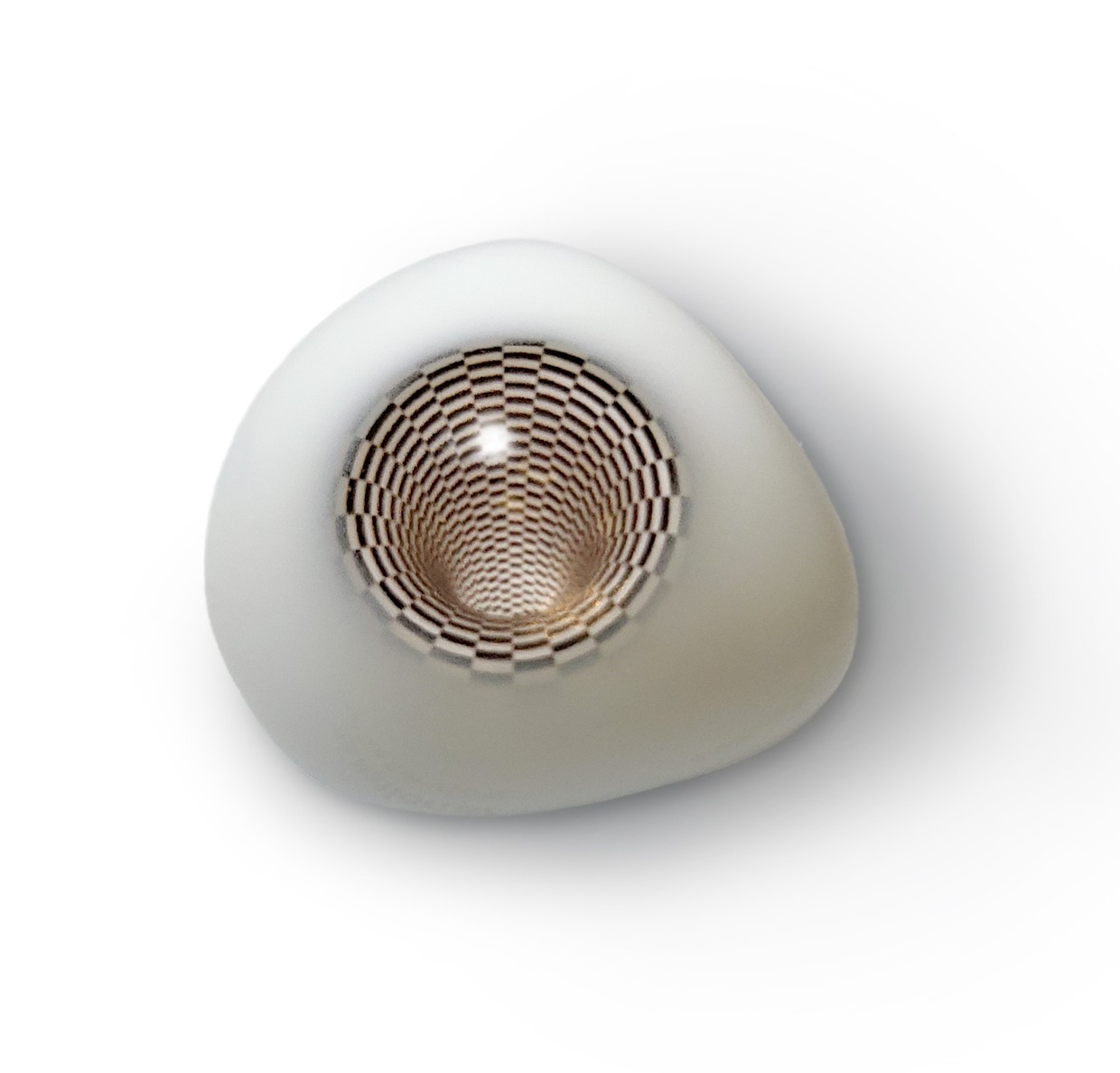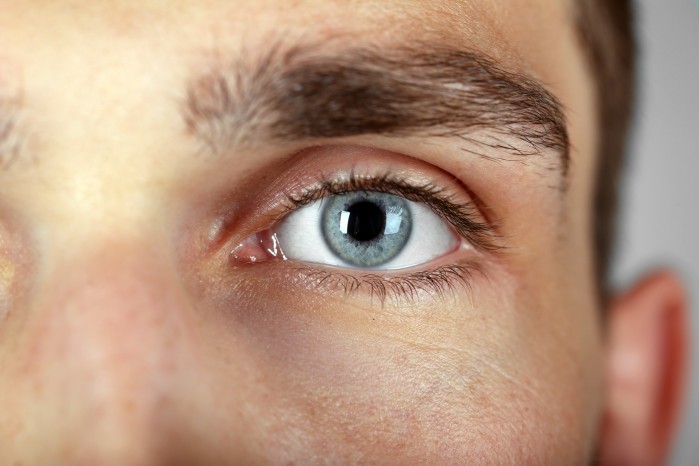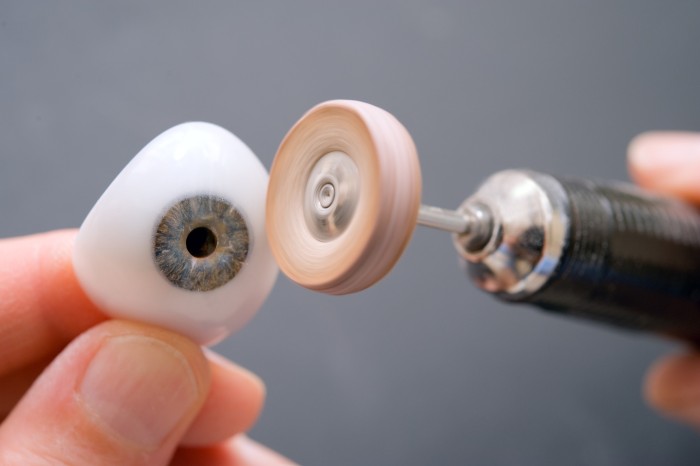Eye discomfort can occur for a number of reasons when you are living with a prosthetic eye. Individuals who experience a comfortable fit in the beginning stages of wearing their artificial eye can experience discomfort after a period of time. All wearers of prosthetic eyes experience things such as teary eyes and mucous discharge from their socket with the prosthetic as well as other issues. It is important to know what you can do to help prevent this at home, when to see your ocularist, and when to consult your ophthalmic practitioner.
Sometimes a gradual build-up off matter can form on the front and back surfaces of the prosthesis. This layer can be very prominent and discoloured or very thin and clear. This will make the surface of the eye rough enough to irritate the tissue underneath the eyelids when blinking. If you feel an itching or scratching sensation with your prosthesis, this more than likely is what is causing it. One cause of this may be that the eyelids are not closing completely over the prosthesis during sleep. This will cause a partially dried film of matter
To combat this, your prosthesis should be properly taken care of at home and also brought in every 12 months for a polishing. These appointments are basically check-ups and should only take about 15-30 minutes. If you find it necessary to clean at home, use your hands to clean it with a mild liquid soap or baby shampoo and rinse with cooled, previously boiled water. Never use alcohol as it will destroy the plastic and cause it to crack. You can also purchase l lubricating prosthetic eye drops which may aid in decreasing mucous discharge.
Foreign bodies under the eyelids can irritate the tissue and cause discomfort as well. Unfortunately, our eyelashes fall out like the rest of our hair sometimes, so it is easy to get one caught underneath your lid when inserting or removing your prosthesis. If you find yourself working in the garage, cooking or outside in the open air for a period of time, you may get sawdust, flour, or dirt particles in your eyes that will also cause discomfort and discharge.
If you feel as though you have a foreign body in your socket, the first thing you should do is clean off the prosthesis. Using a mild liquid soap and rinsing under water should do the trick. You should also follow the steps given to you by your doctor to clean out your eyelids and socket. You may have been prescribed an ointment or medicine by your doctor.
If after following the above steps, you still are experiencing discomfort, schedule an appointment with your Orbital Prosthetist to get a professional polish and cleaning done.
Should you experience any pain, swelling, redness, or a change in the colour of your drainage you should contact your ophthalmic practitioner or GP so that he/she can professionally address your concerns.
Dust in the air can get into the tear film of your eyelids and cause a sort of scrubbing action by the eyelids during blinking. Over time, this can erode the surface polish of your prosthesis. You may also accidentally scratch the prosthesis over the course of everyday activity or while cleaning it. Dropping the artificial eye onto hard, rough surfaces can cause scratches.
Surface polish will naturally fade over time, which is why we recommend coming in for a professional cleaning and polish every 12 months. The more you handle your prosthesis, the more surface polish you will wear off. Deep scratches should be taken care of by your Orbital Prosthetist. The best way to ensure the best comfort and fit of your prosthetic eye is to come in every year for a check-up/cleaning appointment.
Sometimes your socket with the prosthetic eye will produce an abnormal amount of tears or may seem to be very dry all some of the time. Everyone has a different anatomy, so the post-surgery effects and bodily reactions to wearing a prosthetic may vary person to person. These can occur due to season changes, temperature changes or just from not having your eye professionally polished and cleaned recently.
The eye socket holding your artificial eye is a contiguous mucus membrane and will produce considerably larger amounts of tears than your natural eye socket. It is essentially trying to make your prosthetic eye part of “you”.
Dryness can occur for a number of reasons. Your tear ducts may be clogged or completely absent in some cases, the weather can have an effect as well as turning your heat on in your home, or you may need to have your eye cleaned professionally.
If you are experiencing abnormally teary eyes, cleaning your socket by following the steps given to you by your doctor would be a good place to start. Giving your artificial eye a quick wash with mild hand soap and water wouldn’t hurt either. If you are still experiencing teary eyes, schedule a check-up appointment by calling our head office on 01253 951131. Many prosthetic eye wearers have this problem, and it may just be the way your anatomy adjusts to the prosthetic eye.
Dry eyes can be combatted by applying lubricating prosthetic eye drops to your prosthesis. These will help lubricate your socket and can also aid in decreasing mucous.
Your eye socket can change in contour slowly over a long period of time. Post-surgery effects, aging, fat degeneration and even simply readjusting to your new prosthesis can contribute to this. This can increase the depth of the eye socket and pull the back surface into new shapes which no longer fit the contours of the previously well fitted prosthesis. This causes pockets of space between the eye and the tissues, which can fill with tears. Salts will leak out of the tears and irritate the socket and eyelid tissues which, in turn, produce mucoid material.
Your ocularist may be able to recognize if you are having this problem. If that is the case, an adjustment to your current prosthetic eye may be in order.
Where appropriate, your OP can take another impression of your eye socket, which will help locate and fill any of those open spaces.
The socket tissues around the prosthetic eye can become infected as easily as the companion eye. Discomfort and yellow-greenish discharge might indicate infection. Your tear duct (drainage) may be closed. Your ophthalmologist or GP should be consulted in such instances. Ocular prosthesis-wearing patients often experience mucoid discharge, and less often irritation and socket infection – so just because you have noticed some discharge does not necessarily mean your socket is infected.
If you suspect you may have a bacterial infection inside of your eye socket, contact your doctor and schedule an appointment. Orbital Prosthetists may be able to spot an infection and give you some instruction, but they are not doctors. Your practitioner will be able to give you a professional diagnosis. Where appropriate, antibiotics may be prescribed to reduce the discharge and rid the infection.
Viruses travel easily from the eye to the nose and throat. The sneezing, coughing, and fever that accompany a cold or flu can also negatively affect your eyes. With any common cold there may be discomfort, matter and discharge from the socket of the artificial eye, even while the companion eye does not seem to be affected.
Many persons have mild allergies in the surface tissues of their living eyes without being aware of any discomfort. Allergies in the eye can be to such things as house dust, animal hair, plant pollen, and foods. Allergic conjunctivitis generally happens when pollen counts are high, and other allergic symptoms might be present, like itchy eyes.
The prosthetic eye itself is made from acrylic plastic (methyl methacrylate resin). An individual wearing a fully cured and fabricated prosthetic eye should not have any allergic reactions to the material.
Whilst the artificial eye is in your eye socket, it takes up water at a very slow rate. The water will move through the plastic, carrying with it minute quantities of substances with small enough molecules to pass through the spaces. Proteins and bacteria can collect in the plastic which will cause irritation in the eye socket.
When you have an old prosthetic eye with these problems, the only way to fix it will be to fabricate a new prosthetic eye. This new eye will contain fresh plastic and should be a better fit altogether.





